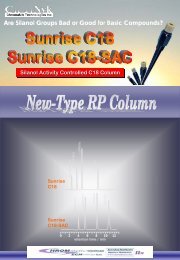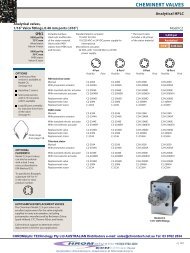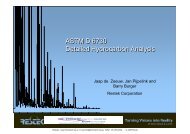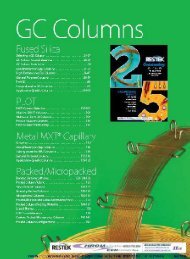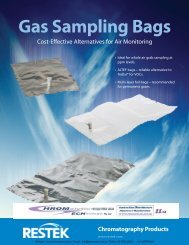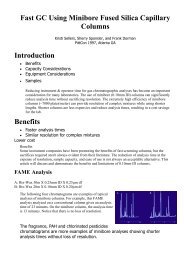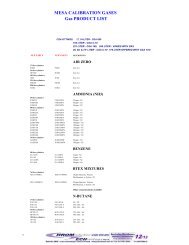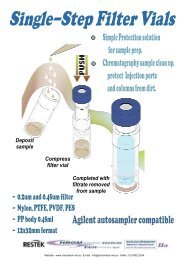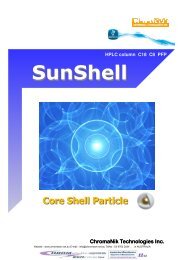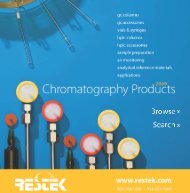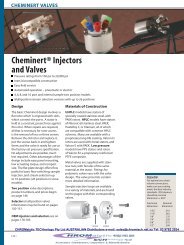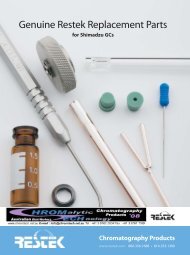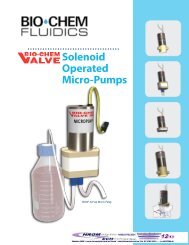Create successful ePaper yourself
Turn your PDF publications into a flip-book with our unique Google optimized e-Paper software.
GC COLUMNS | APPLICATION-SPECIFIC COLUMNS<br />
Petroleum & Petrochemical<br />
ChromaBLOGraphy<br />
Topical and timely insights from top<br />
chromatographers.<br />
Visit us at blog.restek.com<br />
Rt®-Alumina BOND <strong>columns</strong> show<br />
unique retention characteristics for<br />
hydrocarbons.<br />
also available<br />
Metal MXT® Columns<br />
Rugged, flexible, Siltek® treated stainless steel<br />
tubing; inertness comparable to fused silica<br />
tubing. See page 108 for our MXT®-Alumina<br />
BOND/Na2SO4 <strong>columns</strong>.<br />
similar phases<br />
GC-Alumina KCl, CP-Al2O3/KCl<br />
Light Hydrocarbon Analysis<br />
Rt®-Alumina BOND Columns<br />
1. Highly selective for C1-C5 hydrocarbons; separates all unsaturated hydrocarbon<br />
isomers above ambient temperatures.<br />
2. Reactivity of aluminum oxide stationary phase is minimized so that column<br />
response for polar unsaturates, such as dienes, is optimized. Column sensitivity<br />
or response ensures a linear and quantitative chromatographic analysis for these<br />
compounds.<br />
3. Strong bonding prevents particle generation. The column can be used in valve<br />
switching operations, without release of particles that can harm the injection and<br />
detection systems.<br />
4. The Rt®-Alumina BOND column is stable up to 200 °C. If water is adsorbed on<br />
the column, it can be regenerated by conditioning at 200 °C. Full efficiency and<br />
selectivity will be restored.<br />
5. High capacity and loadability give exceptionally symmetric peaks; ideal for volatile<br />
hydrocarbon separations at percent levels, as well as impurity analyses at ppm<br />
concentrations.<br />
Rt®-Alumina BOND/Na2SO4 Columns (fused silica PLOT)<br />
(Na2SO4 deactivation)<br />
ID df temp. limits 30-Meter 50-Meter<br />
0.25mm 4µm to 200°C 19775<br />
0.32mm 5µm to 200°C 19757 19758<br />
0.53mm 10µm to 200°C 19755 19756<br />
Refinery gas hydrocarbons on an Rt®-Alumina BOND/Na2SO4 column.<br />
Rt®-Alumina BOND/KCl Columns (fused silica PLOT)<br />
(KCl deactivation)<br />
• Acetylene elutes before C4 hydrocarbons (impurities in butane/isobutane).<br />
• Methyl acetylene (impurity in 1,3-butadiene) elutes before 1,3-butadiene.<br />
ID df temp. limits 30-Meter 50-Meter<br />
0.25mm 4µm to 200°C 19776<br />
0.32mm 5µm to 200°C 19761 19762<br />
0.53mm 10µm to 200°C 19759 19760<br />
Peak List<br />
1. methane<br />
2. ethane<br />
3. ethylene<br />
4. propane<br />
5. propylene<br />
6. isobutane<br />
7. n-butane<br />
8. propadiene<br />
9. acetylene<br />
10. trans-2-butene<br />
11. 1-butene<br />
12. isobutylene<br />
13. cis-2-butene<br />
14. isopentane<br />
15. n-pentane<br />
16. 1,3-butadiene<br />
17. trans-2-pentene<br />
18. 2-methyl-2-butene<br />
19. 1-pentene<br />
20. cis-2-pentene<br />
21. n-hexane<br />
Column: Rt ® -Alumina BOND/Na2SO4, 30m, 0.53mm ID, 10.0µm (cat.# 19755)<br />
Sample: refinery gas hydrocarbons through C6<br />
Inj.:<br />
10µL split, 40mL/min. split vent flow rate<br />
2mm split Precision ® liner w/wool (cat.# 20823)<br />
Inj. temp.: 200°C<br />
Carrier gas: helium, constant pressure (5.0psi, 34.5kPa)<br />
Linear velocity: 37.3cm/sec. @ 60°C<br />
Oven temp.: 60°C (hold 2 min.) to 200°C @ 10°C/min. (hold 1 min.)<br />
Det.: FID @ 200°C<br />
Instrument: Agilent 5890<br />
GC_PC01139<br />
76 www.restek.com<br />
Website : www.chromtech.net.au E-mail : info@chromtech.net.au TelNo : 03 9762 2034 . . . in AUSTRALIA Mar 2011



